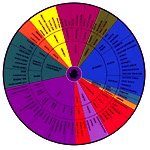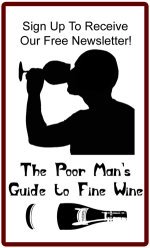Using a Wine Tasting Wheel
 When first learning how to taste wine a wine tasting wheel can be a great help! When you first get into wine you'll realize that having an extensive flavor and aroma vocabulary to draw on can help to describe wines' aromas and flavors. It also helps you begin to share your impressions with others, using a common language which is descriptive and specific.
When first learning how to taste wine a wine tasting wheel can be a great help! When you first get into wine you'll realize that having an extensive flavor and aroma vocabulary to draw on can help to describe wines' aromas and flavors. It also helps you begin to share your impressions with others, using a common language which is descriptive and specific.
What kind of aromas and flavors can I expect to find in wine?
Read any wine critic's tasting notes and you'll see that the aromas and flavors found in a wine are often compared to other things we smell or taste. You might thing that most of these are fruity, I mean wine does come from grapes after all, right? We'll good wines show much more than just the grape flavors they came from. Wines can express a huge cornucopia of aromas from the fruity to the herbaceous to the downright stinky! Aromas that you would never expect from a fruit-based drink, such as earth, tobacco, pepper, coffee, chocolate, and many more, can all show up in the aromas and flavors of various wines.
So how do we recognize and describe these complex aspects of a wine's smell and taste?
Well one part of it is simply getting experience tasting wine to be attuned to the nuances that wines can express. However, early on in our experience, focusing on these nuances may be hard and not come naturally. A great tool in learning this skill is to use a cheat sheet! A wine tasting wheel or wine tasting flavor wheel helps to guide your tasting and give you a list of possible aromas and flavors from which to choose.
The wine tasting wheel gives you the categories of aromas and flavors to focus on and examples of each. By going around the wheel you can assess whether you are sensing any of them or not and make notes accordingly. A wine tasting wheel is not an exhaustive list of all the possible wine aromas and flavors, but it acts as a starting point to focus your analysis of a wine.
Do you need to use the wine tasting flavor wheel for every wine you taste?
The answer to this is no. While early on you may find it very useful to guide your wine tastings, over time you will become more keen and accustomed to picking out details of each wine's character. You will know from experience that some wines can have aromas of earth, or mushrooms, or coffee, or chocolate, and when you smell it, or taste it, you will recognize those flavors.
What does a wine tasting wheel consist of?
There are a few various types of wheels but in generally they have a section for aromas and a section for flavors. Within each section there are subheadings for general classes or families of aromas and flavors, such as floral, fruity, herbaceous/vegetative, spices and oaky/caramelized/smokey aromas. Within each of these sections are an assortment of specific aromas or flavors from which to choose or to evaluate. As you go around the wheel you simply evaluate whether or not you sense any of these in the wine you are tasting.
So, in conclusion, a wine tasting flavor wheel can be a very useful tool in building your armamentarium of wine tasting lingo for aromas and flavors. It helps to focus your tasting notes and helps you express to others the things you like or dislike about a wine. Over time, you will find that the wheel becomes second nature and you do not need to refer to it with each wine. You may even begin to find it restrictive, preferring to use your own descriptive language to describe wines. Another thing to keep in mind is that a wine tasting wheel does not include all possible aromas and flavors so keep an open mind and use it as a guide rather than a be-all end-all of wine descriptors.
Done with the Wine Tasting Wheel page?
Return to the How to Taste Wine Page.





 When first learning how to taste wine a wine tasting wheel can be a great help! When you first get into wine you'll realize that having an extensive flavor and aroma vocabulary to draw on can help to describe wines' aromas and flavors. It also helps you begin to share your impressions with others, using a common language which is descriptive and specific.
When first learning how to taste wine a wine tasting wheel can be a great help! When you first get into wine you'll realize that having an extensive flavor and aroma vocabulary to draw on can help to describe wines' aromas and flavors. It also helps you begin to share your impressions with others, using a common language which is descriptive and specific.


